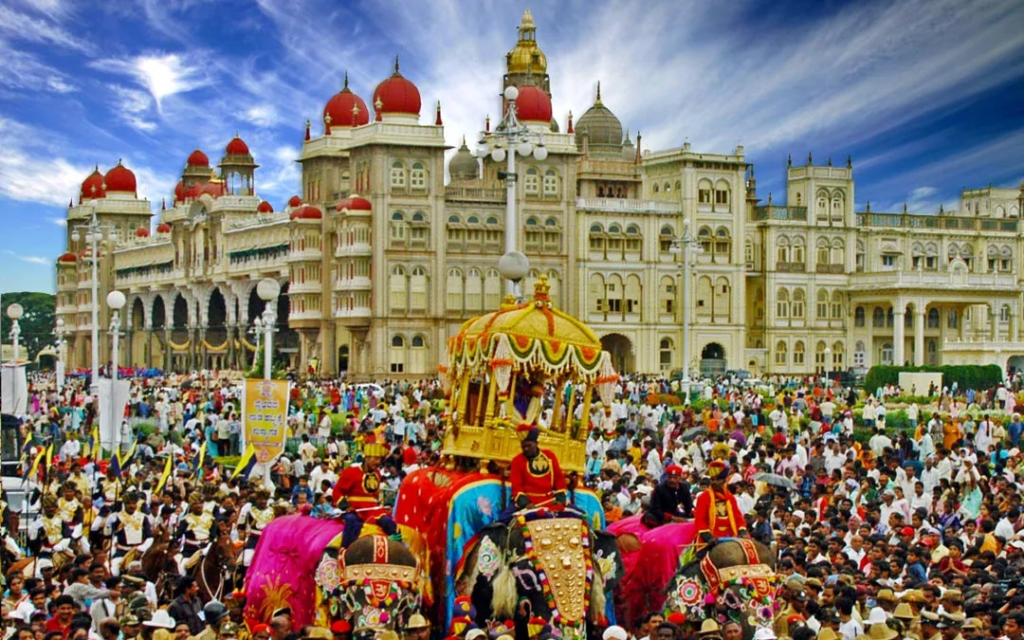Mysore Dasara, a grand festival celebrated with immense enthusiasm, holds an important place in Indian history and culture. Often called the “Nadahabba” (state festival) of Karnataka, it is an occasion that combines religious, cultural, and historical significance. But who started the Dasara festival in Mysore, and how has it evolved? Let’s delve into its origins, history, and traditions.
The Origins of Mysore Dasara

The celebration of Dasara in Mysore is deeply rooted in the traditions of the Wadiyar dynasty. The festival commemorates the triumph of good over evil, symbolized by Goddess Chamundeshwari’s victory over the demon Mahishasura.
However, the formal organization of Dasara as a state event began under the rule of the Wadiyars of Mysore.
Who Started the Mysore Dasara?
The Mysore Dasara festival was first started in 1610 AD by Raja Wadiyar, the ninth ruler of the Wadiyar dynasty. He made the festival an official royal event after shifting his capital from Srirangapatna to Mysore.
The Role of Raja Wadiyar
Raja Wadiyar, a devotee of Goddess Chamundeshwari, initiated the tradition of celebrating Dasara with grandeur. He believed in honoring the Goddess for protecting his kingdom. To this day, the Mysore royal family plays a significant role in maintaining this tradition.
Historical Evolution of Mysore Dasara
The festival has evolved significantly over the centuries. From its inception by Raja Wadiyar to its modern-day grandeur, here’s how Mysore Dasara has transformed:
| Era | Key Developments |
|---|---|
| Raja Wadiyar (1610) | Started the royal Dasara tradition with religious rituals and a simple procession. |
| 18th Century | Hyder Ali and Tipu Sultan disrupted royal celebrations but locals continued informally. |
| Post-Tipu Era | Wadiyar dynasty reinstated the royal celebrations with more elaborate rituals. |
| Modern Era | Became a cultural and tourism spectacle involving the government and royal family. |
How Mysore Dasara is Celebrated Today
1. Jumbo Savari (Elephant Procession)
The grand procession involves the idol of Goddess Chamundeshwari being carried on a decorated golden howdah atop an elephant.
2. Lighting of Mysore Palace
The iconic Mysore Palace is illuminated with over 100,000 lights every evening during the ten-day festival, drawing thousands of visitors.
3. Cultural Programs
Art, music, and dance performances take place across the city, showcasing Karnataka’s rich cultural heritage.
4. Torchlight Parade
The festival concludes with a torchlight parade in the Bannimantap grounds, featuring daring stunts, fireworks, and a military show.
Read Also: Brindavan Gardens Fountain Show Timings
Religious Significance of Mysore Dasara
The festival aligns with Navratri, dedicated to the worship of Goddess Durga in her different forms. On the 10th day, Vijayadashami, the victory of good over evil is celebrated.
The royal family worships the Banni tree (Prosopis cineraria) on this day, symbolizing victory and prosperity. The tradition is linked to the Mahabharata, where the Pandavas hid their weapons in the Banni tree during their exile.
Why Mysore Dasara is Special?
The blend of Religion and Royalty
Mysore Dasara is unique because it combines spiritual devotion with royal pageantry. The traditions initiated by the Wadiyars have been preserved for over 400 years.
Tourism and Cultural Showcase
The festival attracts tourists from around the globe, contributing significantly to Karnataka’s tourism. It’s an excellent opportunity to experience Karnataka’s art, cuisine, and traditions.
FAQs about Mysore Dasara
1. Who started the Mysore Dasara festival?
Raja Wadiyar of the Wadiyar dynasty started Mysore Dasara in 1610 AD.
2. What is the significance of the golden howdah?
The golden howdah carries the idol of Goddess Chamundeshwari during the Jumbo Savari procession, symbolizing the deity’s blessings.
3. How long does the Mysore Dasara last?
The festival spans 10 days, ending on Vijayadashami.
4. Why is the Banni tree worshipped?
The Banni tree is worshipped to honor its association with the Pandavas and their victory, symbolizing courage and success.
5. What is the role of the Mysore Palace during Dasara?
The Mysore Palace becomes the central hub for all major events, including illuminations, cultural programs, and royal rituals.
Also See: KRS Dam Opening and Closing Time 2024
Conclusion
Mysore Dasara is not just a festival; it is a testament to Karnataka’s rich cultural history. Started by Raja Wadiyar in 1610 AD, it has grown into a global spectacle blending devotion, royalty, and celebration. Whether you are a history enthusiast, a cultural explorer, or a tourist, experiencing Mysore Dasara is truly magical.
Would you like to know more about specific traditions or the current year’s schedule for Mysore Dasara? Feel free to ask!